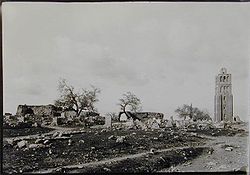.gif)
White Mosque (Ramla)
Encyclopedia
Reconstruction

Nasir Khusraw
Abu Mo’in Hamid ad-Din Nasir ibn Khusraw al-Qubadiani or Nāsir Khusraw Qubādiyānī [also spelled as Nasir Khusrow and Naser Khosrow] Abu Mo’in Hamid ad-Din Nasir ibn Khusraw al-Qubadiani or Nāsir Khusraw Qubādiyānī [also spelled as Nasir Khusrow and Naser Khosrow] Abu Mo’in Hamid ad-Din Nasir ibn...
reported that the mosque had been rebuilt.
After the initial construction Ilyas Ibn Abd Allah supervised the second phase design of the western enclosure wall and the central ablutions building for Ṣalāḥ ad-Dīn Yūsuf ibn Ayyūb (Saladin
Saladin
Ṣalāḥ ad-Dīn Yūsuf ibn Ayyūb , better known in the Western world as Saladin, was an Arabized Kurdish Muslim, who became the first Sultan of Egypt and Syria, and founded the Ayyubid dynasty. He led Muslim and Arab opposition to the Franks and other European Crusaders in the Levant...
) in 1190 CE. The third phase, in 1267-1268, began after the Crusader
Crusades
The Crusades were a series of religious wars, blessed by the Pope and the Catholic Church with the main goal of restoring Christian access to the holy places in and near Jerusalem...
occupation was terminated. On the orders of the Mamluk
Mamluk
A Mamluk was a soldier of slave origin, who were predominantly Cumans/Kipchaks The "mamluk phenomenon", as David Ayalon dubbed the creation of the specific warrior...
sultan al-Zahir Baybars
Baibars
Baibars or Baybars , nicknamed Abu l-Futuh , was a Mamluk Sultan of Egypt. He was one of the commanders of the forces which inflicted a devastating defeat on the Seventh Crusade of King Louis IX of France and he led the vanguard of the Egyptian army at the Battle of Ain Jalut in 1260, which marked...
rededicated as a mosque and was modified by incorporating the dome, placing a new pulpit and prayer niche and adding the minaret. The sultan Muhammad al-Nasir Ibn Qalawun
Al-Nasir Muhammad
Al-Nasir Muhammad b. Cairo 1285, d...
renovated the minaret after an earthquake in October 1318.
The Mamluks commissioned restoration works in 1408.
Muslim
Muslim
A Muslim, also spelled Moslem, is an adherent of Islam, a monotheistic, Abrahamic religion based on the Quran, which Muslims consider the verbatim word of God as revealed to prophet Muhammad. "Muslim" is the Arabic term for "submitter" .Muslims believe that God is one and incomparable...
tradition dating back to 1467 claims that forty of the prophet Muhammad
Muhammad
Muhammad |ligature]] at U+FDF4 ;Arabic pronunciation varies regionally; the first vowel ranges from ~~; the second and the last vowel: ~~~. There are dialects which have no stress. In Egypt, it is pronounced not in religious contexts...
s companion
Sahaba
In Islam, the ' were the companions, disciples, scribes and family of the Islamic prophet...
s were buried in the mosque, which erroneously influenced Western Christian tradition from the 16th century that the White Mosque was originally a church dedicated to the forty martyrs of Sebastia, Nablus
Sebastia, Nablus
Sebastia is a Palestinian village of over 4,500 inhabitants, located in the Nablus Governorate of the West Bank some 12 kilometers northwest of the city of Nablus. The village's total area is 4,810 dunums, the built up area of which comprises 150 dunums...
.
Architecture
Much of the mosque was constructed in white marble with cypress and cedar wood used for the doors. It had four facades organized on a cardinal axis, of which the eastern one is in disrepair. The minaretMinaret
A minaret مناره , sometimes مئذنه) is a distinctive architectural feature of Islamic mosques, generally a tall spire with an onion-shaped or conical crown, usually either free standing or taller than any associated support structure. The basic form of a minaret includes a base, shaft, and gallery....
was the north of the mosque structure, square in shape with five stories, each adorned with window niches, and a balcony towards the top. The minaret was probably influenced by Crusader design, but it was constructed by the Mamluks. The minaret is 27 metres (88.6 ft) tall. There is speculation, however, that the minaret may have earlier been located closer to the center of the mosque as remnants of a square foundation have been found there. Although, this may have been just a fountain. The mosque also featured three underground cisterns with barrel-vaulted aisles below the central court.
Under the courtyard of the mosque, the Abbasids, in 789 CE, under Haroun al-Rashid, constructed enormous cisterns for storage of water which remain intact to this day. Broad pilasters support the barrel-domed ceilings of the cisterns. They were filled with rainwater collected from the area around the mosque and with water carried by an aqueduct from the springs in the hills east of Ramla. The reservoirs provided water for the worshipers at the mosque and filled the pool for ablutions
Wudu
Wuḍhu is the Islamic procedure for washing parts of the body using water often in preparation for formal prayers...
at the center of the courtyard, of which only the foundation remains today.

